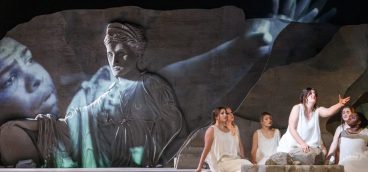Painting the Audience: Quantum’s “Scenes from an Execution” is Artistic Theater

Although we can’t prove that Freud said, “Sometimes a cigar is just a cigar,” we certainly can admit the wisdom in this adage, especially as it concerns the theater, where interpretation has turned into an industry for directors, dramaturgs, audiences, and especially, critics. So rather than write a quotidian, interpretive review, our critic decided to interview himself about the experience of seeing Quantum Theatre’s “Scenes from an Execution,” and attempt to convey some of the more essential aspects of what this production offers the viewer.
The playwright, Howard Barker, has quite an iconoclastic reputation. Is it deserved based on what you saw in this show?
Barker is a self-professed wild man of contemporary British theater. He coined the term “Theater of Catastrophe” to describe his work — and the company dedicated to staging his plays is called “The Wrestling School.” But you don’t really get that vibe from “Scenes From an Execution” (1984). It comes across as elegantly written, artful, and thoughtful; if anything, he’s like the kind of intellectual who hangs out at your house, slips off his shoes, and puts his feet on the coffee table as he sips wine and tells you about an apocryphal event in art history that makes a captivating story.
What about the title of the play? It certainly sounds hyperbolic.
Good question. It sets you up for something melodramatic, but what it refers to is the execution, i.e. creation, of a painting, not the extinction of a life.
Ah, so he’s playing with the audience a bit, then?
Perhaps. But the story is indeed dramatic. It involves a female artist, named Galactia (Lisa Velten Smith), who is hired by Urgentino, the Doge of Venice (Robert Ramirez), to create a commemorative painting of the Battle of Lepanto, in which the Doge’s brother fought. Although the characters are fictional, this event actually happened in 1571, and involved one of the largest sea battles in history, in which a coalition of Catholic states defeated the fleet of the Ottoman Empire.

Quantum usually stages their plays in unconventional, outdoor settings. What is this location like? Will attendees have to walk over train tracks or through a blast furnace?
No, the action transpires in Abiding Missions, a charity organization located in Allentown. Think of an old church sandwiched in the middle of a crowded street of row houses. Chelsea Warren’s compelling set utilizes scaffolding that rises above the audience and incorporates the faded wood and stained glass of the building, such that it makes one feel like they’re sitting inside a 16th-century artist’s studio.
What becomes apparent over the course of the show is that the audience is sitting where the monumental painting is being created. Thus, the audience is — figuratively — the canvass. In fact, at one point, the character Sketchbook (Amy Landis) remarks — looking at the painting (in the direction of the seats) — that there are 200 faces in it, which could be said to be the average number of people attending such a performance.
Weren’t female artists rare in the 16th-century?
Yes indeed. But playwright Barker makes Galactia something of an archetype. She may be partially based on the baroque painter Artemisia Gentileschi, who had extraordinary talent, but was abused and tortured by men in her society. Ms. Smith plays Galactia as a strong, self-confident, and very interior thinker who, in executing her civic commission, wrestles with the dilemma of whether to depict this tragic battle scene — so important to the powers that rule Venice — in a realistic, versus an idealistic way. You can guess how the Doge wants it shown. This then sets up the crucial agon of the action.
What surprised you most about this production?
The elegance of the writing: we have become accustomed to a more colloquial vernacular in contemporary theater. To hear a craftsman of language is actually a treat these days. Also, you never can be sure where the story is going, as Barker lets the characters seemingly make their own decisions, as if he’s watching them from above, but not controlling them. This enables the drama to unfold more naturally.

Talk about the performances.
First of all, Ms. Smith is the primary force that drives the show forward during the first act; she never leaves the stage and in a way directs the other actors who must react to her, much like an actor playing Hamlet. And as Barker’s language is so rich and multi-faceted — such that it could be played many ways — she has to judge and deliver every line in a way that makes sense not just for her part, but for all of the cast. Take her first speech, “Dead men float with their arses in the air. Hating the living, they turn their buttocks up. I have this on authority. Their faces meanwhile peer into the seabed where their bones will lie.” This could be framed comically, or with pathos.
Likewise, the character Prodo (Randy Kovitz), has a crossbolt arrow protruding from his head — reminiscent of that early Steve Martin comedy routine — but makes this unlikely condition believable, as well as entertaining. Again, it’s pathetic, but spiced with comedy, as when he delivers lines such as, “I am a walking manifestation of organic solidarity and the resilience of the Christian state.”
All the actors must strike this kind of balance, and they do, remarkably well. This kind of antinomy occurs in much of the best theatrical writing — think of those bad productions you’ve seen of “Waiting for Godot” when the actors choose to press too hard for laughs, or grandiloquence. It becomes tendentious if taken too far either way. Quantum avoids this.
Is this a result of the direction?
Absolutely. Director Andrew William Smith is like a wedding planner who must find a way for two families of strongly divergent backgrounds to celebrate a potentially dichotomous experience together. In other words, he manages the actors’ delivery much as Barker manages the writing, letting the choices be made which further the play’s agenda, not his. You have to have a strong aesthetic to avoid smothering another artist’s aesthetic.
Is that not one of the underlying themes of this play?
Indeed, and it’s underscored by the inclusion of the character Rivera (Bria Walker-Rhoze) who plays the part of a critic. She represents the traditional view of what critics do, as she declares, “The critic is afraid of the artist and envies her power. She is ashamed of what she secretly believes to be an inferior gift, that of exposition. So instead of serving the artist, she humiliates her.” Galactia’s problems, including her eventual imprisonment for painting the commission in a realistic, rather then idealistic way, stem from the powers that be not recognizing her true gifts, her true strength, as an artist. She is maligned by interpretation, instead of being exalted for impression.
Do the technical aspects further the dramatic agenda of the production?
Very much so. C. Todd Brown’s crepuscular lighting design conveys that unique sense of baroque illumination, common to paintings of this era. His casting the prison scene in almost total darkness — as if channeling cinematographer Gordon Willis’s work in films such as “The Godfather” — comes across as a bold and very effective choice.
In a similar fashion, Steve Shapiro’s sound work has a numinous delicacy that works in harmony with the lighting. He has a gift for projecting the faintness of distant noises that makes them sound as if they are really coming across a great distance, rather than being artificially diminished.
And Angela Vesco’s costumes span the immense range between the sumptuous regality of the Doge’s golden tunic, and the worn, baggy frock of Galactica, which hangs on her body like tired draperies.
Who else is in the cast?
Martin Giles brings his unique, ironic gravitas to the role of Ostensible, the Cardinal, as well playing the mysterious, disembodied voice heard in the darkness during the prison scene. Also excellent are Hansel Tan (Carpeta), Leyla Davis (Supporta), Mariana Garzon Toro (Dementia), and Jerreme Rodriguez (Suffici).
Final question: are there any surprises you can give us a little hint of?
Hmm. . . the ending! You’ll never guess how things work out, but then Galactia is a unique character, and she is able to choose her own destiny. Isn’t this a wonderful surprise in these days of didactic, moralistic theater?
Indeed. So, to summarize, this is really a play that’s just a play?
That would be a matter of interpretation.
SCENES FROM AN EXECUTION continues through April 27th at Abiding Missions, Allentown. $18-65. 412-362-1713 or www.quantumtheatre.com













